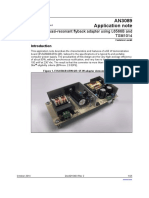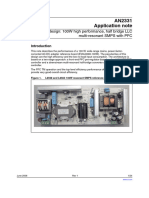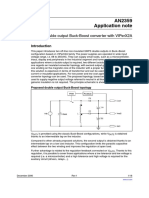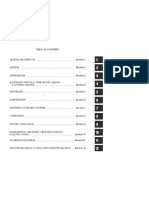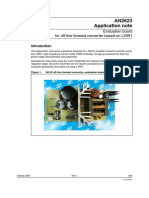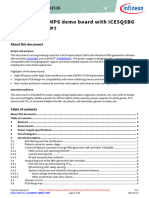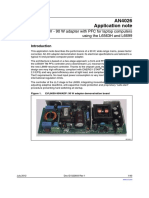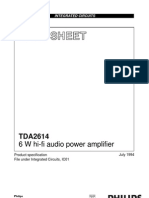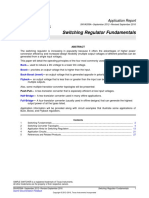An1513 Application Note: Vipower: 30 W Smps Using Viper50A-E
An1513 Application Note: Vipower: 30 W Smps Using Viper50A-E
Uploaded by
bookreader1968Copyright:
Available Formats
An1513 Application Note: Vipower: 30 W Smps Using Viper50A-E
An1513 Application Note: Vipower: 30 W Smps Using Viper50A-E
Uploaded by
bookreader1968Original Title
Copyright
Available Formats
Share this document
Did you find this document useful?
Is this content inappropriate?
Copyright:
Available Formats
An1513 Application Note: Vipower: 30 W Smps Using Viper50A-E
An1513 Application Note: Vipower: 30 W Smps Using Viper50A-E
Uploaded by
bookreader1968Copyright:
Available Formats
AN1513
Application note
VIPower: 30 W SMPS using VIPer50A-E
Introduction
In a growing consumer market, cost effective solutions with good performances and
reliability able to meet energy saving international or local standards (Blue Angel) are
needed.
STMicroelectronics has, among its wide products portfolio, the VIPer product family offering
excellent solutions with all features to design SMPS suitable for consumer applications.
Thanks to the VIPower Technology, these devices combine on the same silicon chip a stateof-the-art PWM control circuit along with an optimized high voltage avalanche rugged
Vertical Power MOSFET.
The benefits obtained using these devices are:
Fewer components compared to a discrete solution
Less space on PCB
Simpler design phase
Automatic burst mode operation in standby for energy savings
Cost effective solution for SMPS
This document describes the results obtained from an off-line SMPS designed with
VIPer50A-E. It has been designed for European mains, providing 30 W on two outputs.
The main target of this application is total power consumption less than 1 W (Blue Angel
Norm) in standby mode delivering an output power of 400 mW.
September 2007
Rev 2
1/13
www.st.com
Contents
AN1513
Contents
1
Schematic . . . . . . . . . . . . . . . . . . . . . . . . . . . . . . . . . . . . . . . . . . . . . . . . . 5
Standby . . . . . . . . . . . . . . . . . . . . . . . . . . . . . . . . . . . . . . . . . . . . . . . . . . . 6
Full load test . . . . . . . . . . . . . . . . . . . . . . . . . . . . . . . . . . . . . . . . . . . . . . . 8
Load step . . . . . . . . . . . . . . . . . . . . . . . . . . . . . . . . . . . . . . . . . . . . . . . . . . 9
Short circuit protection . . . . . . . . . . . . . . . . . . . . . . . . . . . . . . . . . . . . . . 10
Overvoltage protection . . . . . . . . . . . . . . . . . . . . . . . . . . . . . . . . . . . . . . 10
Thermal test . . . . . . . . . . . . . . . . . . . . . . . . . . . . . . . . . . . . . . . . . . . . . . . 11
Conclusion . . . . . . . . . . . . . . . . . . . . . . . . . . . . . . . . . . . . . . . . . . . . . . . . 12
Revision history . . . . . . . . . . . . . . . . . . . . . . . . . . . . . . . . . . . . . . . . . . . 12
2/13
AN1513
List of tables
List of tables
Table 1.
Table 2.
Table 3.
Table 4.
Table 5.
Table 6.
Table 7.
Table 8.
Electrical specifications. . . . . . . . . . . . . . . . . . . . . . . . . . . . . . . . . . . . . . . . . . . . . . . . . . . . . 5
Standby measurements at 65 mA on output 1 . . . . . . . . . . . . . . . . . . . . . . . . . . . . . . . . . . . 6
Standby measurements at 65 mA on output 1 . . . . . . . . . . . . . . . . . . . . . . . . . . . . . . . . . . . 7
Full load measurements . . . . . . . . . . . . . . . . . . . . . . . . . . . . . . . . . . . . . . . . . . . . . . . . . . . . 9
Overvoltage measurements . . . . . . . . . . . . . . . . . . . . . . . . . . . . . . . . . . . . . . . . . . . . . . . . 10
Thermal measurements . . . . . . . . . . . . . . . . . . . . . . . . . . . . . . . . . . . . . . . . . . . . . . . . . . . 11
Transformer specification and construction . . . . . . . . . . . . . . . . . . . . . . . . . . . . . . . . . . . . 11
Document revision history . . . . . . . . . . . . . . . . . . . . . . . . . . . . . . . . . . . . . . . . . . . . . . . . . 12
3/13
List of figures
AN1513
List of figures
Figure 1.
Figure 2.
Figure 3.
Figure 4.
Figure 5.
Figure 6.
Figure 7.
Figure 8.
Figure 9.
4/13
Electrical schematic . . . . . . . . . . . . . . . . . . . . . . . . . . . . . . . . . . . . . . . . . . . . . . . . . . . . . . . 6
Adjustment for frequency reduction . . . . . . . . . . . . . . . . . . . . . . . . . . . . . . . . . . . . . . . . . . . 8
Drain current at full load . . . . . . . . . . . . . . . . . . . . . . . . . . . . . . . . . . . . . . . . . . . . . . . . . . . . 8
Voltage current at full load . . . . . . . . . . . . . . . . . . . . . . . . . . . . . . . . . . . . . . . . . . . . . . . . . . 8
Load transient (Vout1, Vout2) . . . . . . . . . . . . . . . . . . . . . . . . . . . . . . . . . . . . . . . . . . . . . . . . . 9
Load transient (Vcomp, VDD) . . . . . . . . . . . . . . . . . . . . . . . . . . . . . . . . . . . . . . . . . . . . . . . . . 9
Short circuit (Vout1) . . . . . . . . . . . . . . . . . . . . . . . . . . . . . . . . . . . . . . . . . . . . . . . . . . . . . . . 10
Short circuit (Vout2) . . . . . . . . . . . . . . . . . . . . . . . . . . . . . . . . . . . . . . . . . . . . . . . . . . . . . . . 10
Transformer cross section . . . . . . . . . . . . . . . . . . . . . . . . . . . . . . . . . . . . . . . . . . . . . . . . . 11
AN1513
Schematic
Schematic
The power supply topology is a discontinuous current mode flyback converter, designed with
secondary feedback, optocoupler and TL431C. The output voltage regulation is performed
on the 6.5 V, so the output voltage 10 V can change according to the load applied on both
outputs.
To keep the drain voltage at a safe level and to meet the standby power specification, the
clamper used is a Transil 1.5KE220A instead of a classic R-C-D circuit. While the R-C-D
circuit dissipates energy in any load condition, the Transil dissipates energy only when the
drain voltage spike reaches its breakdown voltage. This consideration is important in order
to keep low consumption (<1 W) during standby operation mode.
A Zener diode is also connected to pin Comp for short circuit protection. This diode clamps
the voltage on pin Comp under the maximum value (4.5 V), reducing the maximum power
delivered by the SMPS.
During short circuit due to the short working time, the VDD voltage drops below the
undervoltage lockout threshold and the VIPer starts working in hiccup mode. Even if the
peak output current is higher than the nominal one, thanks to the on/off cycles, the average
current flowing in the shorted output components is kept under control at a safe value
avoiding diodes failure and any other damage to the circuit.
The output rectifiers are Schottky diodes for better efficiency thanks to their lower forward
voltage drop and negligible switching losses.
The output capacitors are low ESR type to minimize the output ripple and to manage the
RMS output ripple current.
Table 1.
Electrical specifications
Parameter
Value
Input voltage
European standard 230Vac15%
Output voltage 1
6,5 V3% at 2.5 A
Output voltage 2
10 V8% at 1.5 A
Standby consumption
<1 W
Efficiency
>80%
Max working ambient temperature
60C
5/13
Standby
AN1513
Standby
The first test performed is the measure of the power consumption during standby operation
mode as the main target of this application is consumption lower than 1 W. For better
accuracy, because the power level is very low, the power supply has been tested with a dc
voltage source.
Table 2.
Standby measurements at 65 mA on output 1
Vin
Iin
Vout1 at 65 mA
Vout2 at 0 mA
Pout
Pin
Efficiency
Switching
frequency
Vdc
mA
Vdc
Vdc
KHz
276
3.33
6.51
16.6
0.42
0.92
46
BURST
325
3.02
6.51
17.5
0.42
0.98
43
BURST
374
2.67
6.51
18.2
0.42
1.0
42
BURST
R6
6K8 1%
22K
10
R3
470R
IC3
TL431C
C15
R4
1K0
150nF
R5
C11
C12
2200uF-16V YXF 2200uF-16V YXF
STPS745F
D6
C6
2n2-Y2
6
C4
1nF
SOURCE
C14
22nF
COMP
DRAIN
D7
2.2nF
C13
22nF
C9
R1
15K
MOLEX
230Vac15%
C1
100nF
F1
FUSE 2A - 5*20
JP1
BZX79-4V3
VDD
OSC
R2
18R
VIPer50A-E
100nF
IC1
3
3
C2
IC2
TCDT1102G
MOUNTED ON HEAT SINK
100uF-50V YXF
C10
1N4148
2,2uH
D4
STTA106
D5
L2
47uF-400V
C5
D1
DF06M
4
L1
B82732- 27mH
4
1
D2
1.5KE220A
C3
1nF
6/13
R7
4K22 1%
RTN
+6.5V
11-12
STPS8H100CF
T1
010150W-C MAGNETICA
MOUNTED ON HEAT SINK
C7
C8
1000uF-25V YXF 1000uF-25V YXF
13-14
D3
MOUNTED ON HEAT SINK
RTN
+10V
Electrical schematic
Figure 1.
AN1513
Standby
The VIPer50A-E is designed to work in burst mode automatically when the power delivered
to the load becomes very low. The burst frequency and its duty-cycle depend on the
transformer parameters and the power delivered. The burst mode takes place when the
power transferred during the minimum on time is greater than the power required by the
load. This should increase the output voltage, but instead the control loop reacts by missing
some cycles. It is important to point out that during this working mode, the output voltage is
always perfectly under control. The result is a working mode where the effective duty-cycle
is much lower than the minimum under normal operation.
To further decrease the consumption during standby operation an additional test has been
done. Of course the burst mode has efficiency proportional to its working duty-cycle and to
work or not in burst mode is also dependent on the primary inductance of the transformer.
Sometimes it is difficult to optimize the primary inductance of the transformer and obtain an
efficient burst. The result can be just a few cycles missed and most of the pulses are
present at switching frequency. It can be an advantage to work at a lower fixed frequency,
giving up the burst operation mode. The network Q1, R8R10 decreases the frequency
sinking current from R1 (timing resistor) when pin Comp (5) is lower than 1.6 V. In this way
the charging current of C13 (timing capacitor) decreases and according to the law
Equation 1
VT = C
-------------I
the frequency starts to reduce until the minimum frequency is at standby load. In steady
state condition at full load the switching frequency has been set to around 70 KHz, while in
standby it is around 30 KHz.
Table 3.
Standby measurements at 65 mA on output 1
Vin
Iin
Vout1 at 65 mA
Vout2 at 0 mA
Pout
Pin
Efficiency
Switching
frequency
Vdc
mA
Vdc
Vdc
KHz
276
2.98
6.51
19.5
0.42
0.82
53
30
325
2.69
6.51
19.6
0.42
0.87
48
29
374
2.48
6.51
19.8
0.42
0.93
45
28
7/13
Full load test
AN1513
Full load test
The parameters checked at full load have been the efficiency and main working parameters
of the VIPer for system reliability. The minimum voltage has been set at 240Vdc considering
the minimum voltage ripple on the bulk capacitor when the power supply is connected to the
ac mains.
The drain voltage spike reaches its maximum value at full load and maximum input voltage.
This spike is caused at turn-off by the energy stored in the primary leakage inductance of
the transformer during the Ton. This is the reason why it is recommended to design the
power transformer with a primary leakage inductance as low as possible. In addition a good
coupling between primary and secondaries improves total regulation, especially in SMPS
with more than one output.
Adjustment for frequency reduction
R1
15K
R2
18R
C9
R8
68K
Figure 2.
VDD
DRAIN
22nF
IC1
R10
Q1
OSC
18K
C13
VIPer50A-E
COMP
SOURCE
2.2nF
BC546
R9
15K
D7
C14
22nF
BZX79-4V3
Figure 3.
Drain current at full load
Figure 4.
Voltage current at full load
The maximum peak voltage measured on the drain is 642 V, thanks to the clamp
1.5KE220A. This value guarantees a reliable operation of VIPer with a good margin with
respect to the maximum BVDSS, which is 700 V. The VIPer is an avalanche rugged device
able to withstand a momentary energy peak caused by voltage greater than 700 V.
8/13
AN1513
Load step
The SMPS meets the specification with efficiency better than 80% at any input voltage
value, as shown in Table 4.
Table 4.
Full load measurements
Full load
Vin
Iin
Vdc
mA
Vdc
240
160
325
374
Vout1 at 2.5 A Vout2 at 1.5 A
Pout
Pin
Efficiency
Vdc
6.50
10.26
31.6
38.4
82.3
118
6.50
10.25
31.6
38.3
82.5
102
6.50
10.25
31.6
38.1
82.9
Load step
This SMPS has been designed to operate under two conditions: standby and full load. In
Figure 5 and Figure 6 show the outputs voltages during load steps from standby and full
load and vice versa. CHA is the resampling of Vout1 highlighting that no undershoot or
overshoot is present during load transient. The same test has been done to show the
behavior of the voltage on pins VDD and Comp.
Figure 5.
Load transient (Vout1, Vout2)
Figure 6.
Load transient (Vcomp, VDD)
9/13
Short circuit protection
AN1513
Short circuit protection
The SMPS is protected against short circuit on both outputs. The short circuit test has been
done with an active load for the complete input voltage range. As shown in Figure 7 and
Figure 8, taken at worst case at 374 Vdc, during short circuit on output1 or output 2, the
SMPS works in hiccup mode keeping the mean output current at a safe value for the
rectifiers, respectively at 3.3 A for output 1 and 2.2 A for output 2. Also the drain voltage
remains at a safe level during short circuit. To achieve these results a Zener diode has been
connected between pin Comp and Source of the VIPer. This Zener clamps the voltage on
pin Comp, limiting the maximum primary peak current. During short circuit the auxiliary
voltage is low because it is proportional to the output voltage. VDD drops under the low
threshold (8 V) blocking the VIPer and beginning the start up cycle. When C12 is charged at
11 V, the VIPer turns on again. It works as long as C12 is discharged to 8 V because the
auxiliary voltage, thanks to the reduced duty-cycle, is not capable of supplying the VIPer.
Figure 7.
Short circuit (Vout1)
Overvoltage protection
Figure 8.
Short circuit (Vout2)
Thanks to the VDD regulation capability, this SMPS is protected against secondary feedback
failure. If the secondary feedback loses control, the voltages increase. As the auxiliary
voltage is proportional to the outputs, VDD increases up to 13 V, which is the typical
regulation value for VIPer50A-E, so the VIPer takes control avoiding any damage to the
output capacitors and rectifiers. Table 5 gives the measurements in standby and at full load
with R6 removed from the board to simulate secondary feedback failure.
Table 5.
10/13
Overvoltage measurements
Operation mode
Vout1
Vout2
Standby
9.5V
22.5 V
Full load
7.2V
11.2 V
AN1513
Thermal test
Thermal test
For system reliability it is important to keep device temperature at a safe level, considering
the maximum ambient temperature especially when the board is inside a chassis. In Table 6
shows the temperatures measured on the SMPS after 4 hours of warm-up at full load at
nominal input voltage 230Vac: the results are compatible with robust design rules.
Table 6.
Thermal measurements
Table 7.
Measure point
Temperature (C)
Ambient
25
VIPer50A-E
47
STPS8H100F
53
STPS745
58
1.5KE220A
84
STTA106
55
DFO6M
52
T1 Ferrite
53
Transformer specification and construction
Parameter
Primary inductance
Value
670 H 8%
58 TURNS
Winding output1
4 TURNS
Winding output2
6 TURNS
Auxiliary winding
6 TURNS
Primary leakage inductance
Figure 9.
12 H
1.8% of Lp
Core
EPCOS ETD29-N67
Code
B66358-G500-X67
Transformer cross section
11/13
Conclusion
AN1513
Conclusion
The main specification requirements of this application have been reached and thanks to
the VIPer features, it also has been demonstrated that a quite difficult task such as attaining
very low power consumption in standby is easily achievable.
Revision history
Table 8.
12/13
Document revision history
Date
Revision
Changes
04-Jan-2005
First issue
27-Sep-2007
The document has been reformatted
VIPer50A becomes VIPer50A-E
AN1513
Please Read Carefully:
Information in this document is provided solely in connection with ST products. STMicroelectronics NV and its subsidiaries (ST) reserve the
right to make changes, corrections, modifications or improvements, to this document, and the products and services described herein at any
time, without notice.
All ST products are sold pursuant to STs terms and conditions of sale.
Purchasers are solely responsible for the choice, selection and use of the ST products and services described herein, and ST assumes no
liability whatsoever relating to the choice, selection or use of the ST products and services described herein.
No license, express or implied, by estoppel or otherwise, to any intellectual property rights is granted under this document. If any part of this
document refers to any third party products or services it shall not be deemed a license grant by ST for the use of such third party products
or services, or any intellectual property contained therein or considered as a warranty covering the use in any manner whatsoever of such
third party products or services or any intellectual property contained therein.
UNLESS OTHERWISE SET FORTH IN STS TERMS AND CONDITIONS OF SALE ST DISCLAIMS ANY EXPRESS OR IMPLIED
WARRANTY WITH RESPECT TO THE USE AND/OR SALE OF ST PRODUCTS INCLUDING WITHOUT LIMITATION IMPLIED
WARRANTIES OF MERCHANTABILITY, FITNESS FOR A PARTICULAR PURPOSE (AND THEIR EQUIVALENTS UNDER THE LAWS
OF ANY JURISDICTION), OR INFRINGEMENT OF ANY PATENT, COPYRIGHT OR OTHER INTELLECTUAL PROPERTY RIGHT.
UNLESS EXPRESSLY APPROVED IN WRITING BY AN AUTHORIZED ST REPRESENTATIVE, ST PRODUCTS ARE NOT
RECOMMENDED, AUTHORIZED OR WARRANTED FOR USE IN MILITARY, AIR CRAFT, SPACE, LIFE SAVING, OR LIFE SUSTAINING
APPLICATIONS, NOR IN PRODUCTS OR SYSTEMS WHERE FAILURE OR MALFUNCTION MAY RESULT IN PERSONAL INJURY,
DEATH, OR SEVERE PROPERTY OR ENVIRONMENTAL DAMAGE. ST PRODUCTS WHICH ARE NOT SPECIFIED AS "AUTOMOTIVE
GRADE" MAY ONLY BE USED IN AUTOMOTIVE APPLICATIONS AT USERS OWN RISK.
Resale of ST products with provisions different from the statements and/or technical features set forth in this document shall immediately void
any warranty granted by ST for the ST product or service described herein and shall not create or extend in any manner whatsoever, any
liability of ST.
ST and the ST logo are trademarks or registered trademarks of ST in various countries.
Information in this document supersedes and replaces all information previously supplied.
The ST logo is a registered trademark of STMicroelectronics. All other names are the property of their respective owners.
2007 STMicroelectronics - All rights reserved
STMicroelectronics group of companies
Australia - Belgium - Brazil - Canada - China - Czech Republic - Finland - France - Germany - Hong Kong - India - Israel - Italy - Japan Malaysia - Malta - Morocco - Singapore - Spain - Sweden - Switzerland - United Kingdom - United States of America
www.st.com
13/13
You might also like
- Abc of Power Modules: Functionality, Structure and Handling of a Power ModuleFrom EverandAbc of Power Modules: Functionality, Structure and Handling of a Power ModuleNo ratings yet
- Buck Za Led An2754Document20 pagesBuck Za Led An2754JaskovskiNo ratings yet
- CD00252755 MR4030Document25 pagesCD00252755 MR4030Heriberto Flores Ampie100% (1)
- Ice 2a265Document35 pagesIce 2a265Marcio EmersonNo ratings yet
- AN2252 Application NoteDocument21 pagesAN2252 Application NoteAldemar Algarra GaitánNo ratings yet
- 4 X 50 W MOSFET Quad Bridge Power Amplifier: FeaturesDocument18 pages4 X 50 W MOSFET Quad Bridge Power Amplifier: FeaturesEderson MauriceiaNo ratings yet
- AN3172 Application Note: 19 V - 90 W Adapter With PFC For Laptop Computers Using The L6563H and L6599ADocument31 pagesAN3172 Application Note: 19 V - 90 W Adapter With PFC For Laptop Computers Using The L6563H and L6599ARodrigo BonfanteNo ratings yet
- AN2317 Application Note: STPM01 Programmable, Single-Phase Energy Metering IC External CircuitsDocument27 pagesAN2317 Application Note: STPM01 Programmable, Single-Phase Energy Metering IC External CircuitsJitender SharmaNo ratings yet
- TDA7384A: 4 X 42W Quad Bridge Car Radio AmplifierDocument14 pagesTDA7384A: 4 X 42W Quad Bridge Car Radio Amplifierbeta2009No ratings yet
- Constant Current From CV PDFDocument20 pagesConstant Current From CV PDFxiliantonioNo ratings yet
- Data SheetDocument23 pagesData Sheetmichaelliu123456No ratings yet
- TDA7850Document18 pagesTDA7850Ricardo AlfaroNo ratings yet
- DC Motor Speed Control BC201Document24 pagesDC Motor Speed Control BC201ROSEMARIO PORFIRIO100% (1)
- Eval6598 100wDocument24 pagesEval6598 100wمجتبى مهند سمير عبد عليNo ratings yet
- An2359 Application Note: Double Output Buck-Boost Converter With Viperx2ADocument18 pagesAn2359 Application Note: Double Output Buck-Boost Converter With Viperx2AYayan SukmaNo ratings yet
- 4 Watt Led Driver CircuitDocument17 pages4 Watt Led Driver CircuitNomade VoyageurNo ratings yet
- Viper 27Document31 pagesViper 27javierrincon800No ratings yet
- 502 Maqnual PDFDocument18 pages502 Maqnual PDFmantenimiento74No ratings yet
- Ice 2 A 280Document36 pagesIce 2 A 280Marimuthu RajNo ratings yet
- 71r3000 (Ref. HR 5097)Document40 pages71r3000 (Ref. HR 5097)payolin77No ratings yet
- VNH2SP30 e PDFDocument33 pagesVNH2SP30 e PDFservitecdjNo ratings yet
- Different Terms of LDO - TIDocument13 pagesDifferent Terms of LDO - TIbkrebtelNo ratings yet
- 1HS01G PDFDocument18 pages1HS01G PDFAldo TonatoNo ratings yet
- TDA7388A: 4 X 42W Quad Bridge Car Radio AmplifierDocument13 pagesTDA7388A: 4 X 42W Quad Bridge Car Radio AmplifierJuan de la RosaNo ratings yet
- Ucc3842 App Note PDFDocument19 pagesUcc3842 App Note PDFRakesh RakeeNo ratings yet
- Denison Ec01 A10Document17 pagesDenison Ec01 A10Margaret DaughertyNo ratings yet
- B&S SM 270962 Single Cyl L-Head Sec07C AlternatorsDocument25 pagesB&S SM 270962 Single Cyl L-Head Sec07C AlternatorsBruno PilieciNo ratings yet
- Scea 030 ADocument17 pagesScea 030 ACarlos EstevesNo ratings yet
- LAW 420 LAW 520: Service ManualDocument46 pagesLAW 420 LAW 520: Service ManualquangppNo ratings yet
- Dla001d L6599DDocument36 pagesDla001d L6599DBRIGHT_SPARK57% (7)
- 2.5A Output Current Gate Driver Optocoupler: Features DescriptionDocument11 pages2.5A Output Current Gate Driver Optocoupler: Features DescriptiononafetsNo ratings yet
- an4260-12-v-150-ma-nonisolated-buck-converter-using-the-viper06xs-from-the-viper-plus-family-stmicroelectronicsDocument29 pagesan4260-12-v-150-ma-nonisolated-buck-converter-using-the-viper06xs-from-the-viper-plus-family-stmicroelectronicsprt8553No ratings yet
- CD 00279018Document25 pagesCD 00279018hsyntunaNo ratings yet
- VIPower: VIPer22A Dual Output Reference Board 90 To 264 VAC Input, 10W OutputDocument20 pagesVIPower: VIPer22A Dual Output Reference Board 90 To 264 VAC Input, 10W OutputLullaby summerNo ratings yet
- VIPER17LN-Fixed Frequency 6W High Performance Off Line High Voltage Converter-STDocument33 pagesVIPER17LN-Fixed Frequency 6W High Performance Off Line High Voltage Converter-STbookreader1968No ratings yet
- AN4214 Application Note: High Power Factor Flyback Converter Using The L6564Document37 pagesAN4214 Application Note: High Power Factor Flyback Converter Using The L6564GreenoceanNo ratings yet
- Evaluation Board For Off-Line Forward Converter Based On L5991Document25 pagesEvaluation Board For Off-Line Forward Converter Based On L5991Grzegorz WegnerNo ratings yet
- LinuxCNC IntegratorDocument21 pagesLinuxCNC IntegratorNguyễnNgọcMinhNo ratings yet
- 1Document5 pages1Prajnyajit MohantyNo ratings yet
- Improved High-Voltage Resonant Controller: FeaturesDocument31 pagesImproved High-Voltage Resonant Controller: Featuressontuyet82No ratings yet
- KBRG 212d Thruhole ManualDocument17 pagesKBRG 212d Thruhole ManualJulio FerminNo ratings yet
- CO2038 Lab4Document18 pagesCO2038 Lab427-Lục Tấn Phúc-11A8No ratings yet
- AKAI-GX210D (Operator S Manual)Document15 pagesAKAI-GX210D (Operator S Manual)jxv7bz97wkNo ratings yet
- 2794 990 RevADocument36 pages2794 990 RevAgovindarulNo ratings yet
- L 6599 DDocument36 pagesL 6599 DVidal VelasquezNo ratings yet
- 60W1 ApplicationNotes v01 - 00 ENDocument36 pages60W1 ApplicationNotes v01 - 00 ENorkun burkayNo ratings yet
- $ Power Supply DesignDocument164 pages$ Power Supply Designquangntn88No ratings yet
- Reference Design Wide Range 200W L6599-BasedDocument35 pagesReference Design Wide Range 200W L6599-Basedrohit.rajNo ratings yet
- UCC39421 3.3-V SEPIC Evaluation Board: User's GuideDocument7 pagesUCC39421 3.3-V SEPIC Evaluation Board: User's GuidebensumbbNo ratings yet
- BTS50080-1TMB: Smart High-Side Power Switch Profet One ChannelDocument27 pagesBTS50080-1TMB: Smart High-Side Power Switch Profet One Channelbünyamin altunNo ratings yet
- Tda 7388Document11 pagesTda 7388Lucas Meister BarichelloNo ratings yet
- Level SwitchDocument16 pagesLevel SwitchOlanshileNo ratings yet
- dm00044787 19 V 90 W Adapter With PFC For Laptop Computers Using The l6563h and l6699 StmicroelectronicsDocument40 pagesdm00044787 19 V 90 W Adapter With PFC For Laptop Computers Using The l6563h and l6699 StmicroelectronicssacralNo ratings yet
- LinuxCNC IntegratorDocument21 pagesLinuxCNC IntegratormilknaniNo ratings yet
- Reference Guide To Useful Electronic Circuits And Circuit Design Techniques - Part 1From EverandReference Guide To Useful Electronic Circuits And Circuit Design Techniques - Part 1Rating: 2.5 out of 5 stars2.5/5 (3)
- DC/DC Converter Handbook: SMPS topologies from an EMC point of viewFrom EverandDC/DC Converter Handbook: SMPS topologies from an EMC point of viewNo ratings yet
- Practical Magnetic Design: Inductors and Coupled Inductors: Power Supply Design SeminarDocument23 pagesPractical Magnetic Design: Inductors and Coupled Inductors: Power Supply Design Seminarbookreader1968No ratings yet
- Obsolete Product(s) - Obsolete Product(s) : Control Circuit For Switch Mode Power Supplies Using Mos TransistorsDocument7 pagesObsolete Product(s) - Obsolete Product(s) : Control Circuit For Switch Mode Power Supplies Using Mos Transistorsbookreader1968No ratings yet
- Tidu227 PDFDocument11 pagesTidu227 PDFbookreader1968No ratings yet
- AP9T15GHDocument4 pagesAP9T15GHbookreader1968No ratings yet
- Tda2614 CNV 2Document11 pagesTda2614 CNV 2octalmNo ratings yet
- Silicon NPN Triple Diffusion Planar Type Darlington: Power TransistorsDocument3 pagesSilicon NPN Triple Diffusion Planar Type Darlington: Power Transistorsbookreader1968No ratings yet
- MJH11017, MJH11019, MJH11021 (PNP) MJH11018, MJH11020, MJH11022 (NPN) Complementary Darlington Silicon Power TransistorsDocument8 pagesMJH11017, MJH11019, MJH11021 (PNP) MJH11018, MJH11020, MJH11022 (NPN) Complementary Darlington Silicon Power Transistorsbookreader1968No ratings yet
- Silicon PNP Darlington Power Transistors: Savantic Semiconductor Product SpecificationDocument3 pagesSilicon PNP Darlington Power Transistors: Savantic Semiconductor Product Specificationbookreader1968No ratings yet
- En An Ce / Co Nti Nu Ed: Silicon PNP Epitaxial Planar Type DarlingtonDocument4 pagesEn An Ce / Co Nti Nu Ed: Silicon PNP Epitaxial Planar Type Darlingtonbookreader1968No ratings yet
- Inte Na Nce / Dis Con Tinu Ed: Silicon NPN Triple Diffusion Planar Type DarlingtonDocument4 pagesInte Na Nce / Dis Con Tinu Ed: Silicon NPN Triple Diffusion Planar Type Darlingtonbookreader1968No ratings yet
- Fundamentals of On-Resistance in Load Switches: Application ReportDocument9 pagesFundamentals of On-Resistance in Load Switches: Application Reportbookreader1968No ratings yet
- En An Ce / Co Nti Nu Ed: Silicon PNP Epitaxial Planar Type DarlingtonDocument4 pagesEn An Ce / Co Nti Nu Ed: Silicon PNP Epitaxial Planar Type Darlingtonbookreader1968No ratings yet
- Switching Regulator Fundamentals: Application ReportDocument28 pagesSwitching Regulator Fundamentals: Application Reportbookreader1968No ratings yet
- SLVA812Document7 pagesSLVA812bookreader1968No ratings yet
- Inte Na Nce / Dis Con Tinu Ed: Silicon NPN Triple Diffusion Planar Type DarlingtonDocument4 pagesInte Na Nce / Dis Con Tinu Ed: Silicon NPN Triple Diffusion Planar Type Darlingtonbookreader1968No ratings yet
- SLUP079Document46 pagesSLUP079bookreader1968No ratings yet
- SLUA787Document5 pagesSLUA787bookreader1968No ratings yet
- Switching Regulator Fundamentals: Application ReportDocument28 pagesSwitching Regulator Fundamentals: Application Reportbookreader1968No ratings yet
- Tidu227 PDFDocument11 pagesTidu227 PDFbookreader1968No ratings yet
- INA28 XDocument36 pagesINA28 Xbookreader1968No ratings yet
- SBOA169ADocument3 pagesSBOA169Abookreader1968No ratings yet
- High-Side Motor Current Monitoring For Over-Current ProtectionDocument3 pagesHigh-Side Motor Current Monitoring For Over-Current Protectionbookreader1968No ratings yet
- BF2040Document11 pagesBF2040bookreader1968No ratings yet
- Arf1500 PDFDocument4 pagesArf1500 PDFbookreader1968No ratings yet
- Lecture 2 DetectorsDocument35 pagesLecture 2 DetectorsEdis ĐedovićNo ratings yet
- Slua 121Document4 pagesSlua 121Chinedu EgbusiriNo ratings yet
- Volume Ii - 250kva Trensformers, Ner, Nic & Ancillary Electrical Equipment PDFDocument119 pagesVolume Ii - 250kva Trensformers, Ner, Nic & Ancillary Electrical Equipment PDFSunil G ParakkalNo ratings yet
- Motor Control CentersDocument3 pagesMotor Control CentersTeh SpNo ratings yet
- Technical Data Sheet For GIS 18-2-2022Document14 pagesTechnical Data Sheet For GIS 18-2-2022sami ul haqNo ratings yet
- "Original Easy-To-Use Design" - How About Giving It A Try?: Uv-Led Spot Light SourceDocument4 pages"Original Easy-To-Use Design" - How About Giving It A Try?: Uv-Led Spot Light SourceJorge Angelo NicheNo ratings yet
- Physics Syllabus Semester - SystemDocument33 pagesPhysics Syllabus Semester - Systemdipu212100% (1)
- SGK Physics and Chemistry Material 2011Document118 pagesSGK Physics and Chemistry Material 2011Badri Nath0% (1)
- RE-2 User Guide Multi-LanguageDocument60 pagesRE-2 User Guide Multi-LanguagecenuclearNo ratings yet
- Power QualityDocument32 pagesPower QualityLindiasariNo ratings yet
- Transformer Instruction Manual: GMX Ground Mounted TransformersDocument20 pagesTransformer Instruction Manual: GMX Ground Mounted TransformersnooruddinkhanNo ratings yet
- Phymerge PDFDocument181 pagesPhymerge PDFvenkateshNo ratings yet
- Boundary Conditions OnDocument8 pagesBoundary Conditions OnravindarsinghNo ratings yet
- Ele 202 Course Outline 2017Document4 pagesEle 202 Course Outline 2017ibNo ratings yet
- Xi FP 150W 0 2-0 7A SNLDAE 230V S240 SXT 929002128606Document9 pagesXi FP 150W 0 2-0 7A SNLDAE 230V S240 SXT 929002128606Marco TrentiniNo ratings yet
- IEC 60060-1 StatusDocument47 pagesIEC 60060-1 StatusONUR YILMAZNo ratings yet
- 3.0A, 15V, Step-Down Switching Regulator: FeaturesDocument9 pages3.0A, 15V, Step-Down Switching Regulator: FeaturesSoumyakant DasNo ratings yet
- ET-343: Telecommunication Total Contact HoursDocument8 pagesET-343: Telecommunication Total Contact HoursIsrar UllahNo ratings yet
- ELEC334 Lab 5 Fall2018Document6 pagesELEC334 Lab 5 Fall2018EnamulduNo ratings yet
- Experiment 2-The Emitter-Follower AmplifierDocument2 pagesExperiment 2-The Emitter-Follower AmplifierEd Judge100% (1)
- E86060 k1010 A221 A1 7600Document164 pagesE86060 k1010 A221 A1 7600hugorococNo ratings yet
- RadioKot - Effective Powerful Charging and Desulfation Device For Batteries of 10-100 A - HDocument10 pagesRadioKot - Effective Powerful Charging and Desulfation Device For Batteries of 10-100 A - HLUis PEpeNo ratings yet
- Tube Light ManualDocument2 pagesTube Light ManualSwaroop MallickNo ratings yet
- LV Switchgear Site Inspection Report FormatDocument2 pagesLV Switchgear Site Inspection Report FormatAhmed HassanNo ratings yet
- Mia JurnalDocument13 pagesMia JurnalMia SasiNo ratings yet
- E07-S02 - 1 Gen. 13.8KV (Without Turbine)Document13 pagesE07-S02 - 1 Gen. 13.8KV (Without Turbine)Muhammad IrfanNo ratings yet
- Liquid Sensor Level TIDocument23 pagesLiquid Sensor Level TIDanielViasusNo ratings yet
- Heat Sensitive SwitchDocument1 pageHeat Sensitive Switchvinay reddyNo ratings yet
- CLL 51..seriesDocument1 pageCLL 51..seriesDharmesh ChanawalaNo ratings yet
- Golden Golden Job Card Rev 1.0Document9 pagesGolden Golden Job Card Rev 1.0Kholis JaimonNo ratings yet


